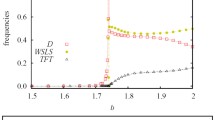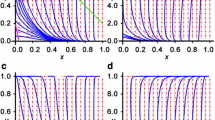Abstract
We study conditions for weak selection to favor tit-for-tat (TFT) over AllD in a repeated Prisoner’s Dilemma game played in a finite population subdivided into three subpopulations under the assumption of cyclic dominance in asymmetric interactions. Assuming parent-independent mutation and uniform migration, we show that TFT is more abundant that AllD in the stationary state if the defection cost incurred by individuals in interaction with dominant defecting individuals exceeds some threshold value. This threshold value decreases as the number of repetitions of the game, the population size, or the mutation rate increases, but increases as the migration rate increases. The same conclusions hold in the case of linear dominance.


Similar content being viewed by others
References
Antal T, Nowak MA, Traulsen A (2009) Strategy abundance in \(2\times 2\) games for arbitrary mutation rates. J Theor Biol 257:340–344
Antal T, Traulsen A, Ohtsuki H, Tarnita CE, Nowak MA (2009) Mutation-selection equilibrium in games with multiple strategies. J Theor Biol 258:614–622
Antal T, Ohtsuki H, Wakeley J, Taylor PD, Nowak MA (2009) Evolutionary game dynamics in phenotype space. Proc Natl Acad Sci USA 106:8597–8600
Axelrod RM (1984) The evolution of cooperation. Basic Books, New York
Axelrod RM, Hamilton WD (1981) The evolution of cooperation. Science 211:1390–1396
Eshel I (1996) On the changing concept of evolutionary population stability as a reflection of a changing point of view in the quantitative theory of evolution. J Math Biol 34:485–510
Fudenberg D, Imhof LA (2006) Imitation processes with small mutations. J Econ Theory 131:251–262
Fudenberg D, Nowak MA, Taylor C, Imhof LA (2006) Evolutionary game dynamics in finite populations with strong selection and weak mutation. Theor Popul Biol 70:352–363
Fudenberg D, Tirole J (1991) Game theory. MIT Press, Cambridge
Hamilton WD (1964) The genetical evolution of social behaviour. I and II. J Theor Biol 7:1–52
Hammerstein P (1981) The role of asymmetries in animal contests. Anim Behav 29:578–581
Hauert C, Doebeli M (2004) Spatial structure often inhibits the evolution of cooperation in the snowdrift game. Nature 428:643–646
Hilbe C (2011) Local replicator dynamics: a simple link between deterministic and stochastic models of evolutionary game theory. Bull Math Biol 73:2068–2087
Hofbauer J, Sigmund K (1988) The theory of evolution and dynamical systems. Cambridge University Press, Cambridge
Hofbauer J, Sigmund K (2003) Evolutionary game dynamics. Bull Amer Math Soc 40:479–519
Hofbauer J, Schuster P, Sigmund K (1979) A note on evolutionary stable strategies and games dynamics. J Theor Biol 81:609–612
Imhof LA, Nowak MA (2006) Evolutionary game dynamics in a Wright–Fisher process. J Math Biol 52:667–681
Ladret V, Lessard S (2007) Fixation probability for a beneficial allele and a mutant strategy in a linear game under weak selection in a finite island model. Theor Popul Biol 72:409–425
Ladret V, Lessard S (2008) Evolutionary game dynamics in a finite asymmetric two-deme population and emergence of cooperation. J Theor Biol 255:137–151
Lessard S (2005) Long-term stability from fixation probabilities in finite populations: new perspectives for ESS theory. Theor Popul Biol 68:19–27
Lessard S (2007) Cooperation is less likely to evolve in a finite population with a highly skewed distribution of family size. Proc R Soc B 274:1861–1865
Lessard S (2011a) Effective game matrix and inclusive payoff in group-structured populations. Dyn Games Appl 1:301–318
Lessard S (2011b) Evolutionary game dynamics. Am Math Soc 69:143–171
Lessard S, Ladret V (2007) The probability of fixation of a single mutant in an exchangeable selection model. J Math Biol 54:721–744
Lessard S, Lahaie P (2009) Fixation probability with multiple alleles and projected average allelic effect on selection. Theor Popul Biol 75:266–277
Maynard Smith J (1982) Evolution and the theory of games. Cambridge University Press, Cambridge
Maynard Smith J, Price GR (1973) The logic of animal conflict. Nature 246:15–18
Nash J (1951) Non-cooperative games and spatial chaos. Ann Math 54:286–295
Nowak MA (2006a) Evolutionary dynamics. Harvard University Press, Cambridge
Nowak MA (2006b) Five rules for the evolution of cooperation. Science 314:1560–1563
Nowak MA, May R (1992) Evolutionary games and spatial chaos. Nature 359:826–829
Nowak MA, Sasaki A, Taylor C, Fudenberg D (2004) Emergence of cooperation and evolutionary stability in finite populations. Nature 428:646–650
Nowak MA, Sigmund K (2007) How populations cohere: five rules for cooperation. In Theoretical Ecology, Third Edition. Oxford Press, 7–16.
Nowak MA, Tarnita CE, Antal T (2010) Evolutionary dynamics in structured populations. Phil Trans R Soc B 365:19–30
Ohtsuki H, Nowak MA (2006a) Evolutionary games on cycles. Proc R Soc B 273:2249–2256
Ohtsuki H, Nowak MA (2006b) The replicator equation on graphs. J Theor Biol 243:86–97
Ohtsuki H, Hauert C, Lieberman E, Nowak MA (2006) A simple rule for the evolution of cooperation on graphs and social networks. Nature 441:502–505
Ohtsuki H, Pacheco J, Nowak MA (2007) Evolutionary graph theory: breaking the symmetry between interaction and replacement. J Theor Biol 246:681–694
Osborne MJ, Rubinstein A (1994) A course in game theory. MIT Press, Cambridge
Rousset F (2003) A minimal derivation of convergence stability measures. J Theor Biol 221:665–668
Rousset F (2006) Separation of time scales, fixation probabilities and convergence to evolutionarily stable states under isolation by distance. Theor Popul Biol 69:165–179
Rousset F, Billiard S (2000) A theoretical basis for measures of kin selection in subdivided populations: finite populations and localized dispersal. J Evol Biol 13:814–825
Tao Y, Xu JJ, Li C, Cressman R (2013) Dominance hierarchies induce a population’s full cooperation. Submitted to games. [Preprint]
Tarnita CE, Antal T, Nowak MA (2009) Mutation-selection equilibrium in games with mixed strategies. J Theor Biol 261:50–57
Tarnita CE, Antal T, Ohtsuki H, Nowak MA (2009) Evolutionary dynamics in set structured populations. Proc Natl Acad Sci USA 106:8601–8604
Tarnita CE, Ohtsuki H, Antal T, Fu F, Nowak MA (2009) Strategy selection in structured populations. J Theor Biol 259:570–581
Tarnita CE, Wage N, Nowak MA (2011) Multiple strategies in structured populations. Proc Natl Acad Sci USA 108:2334–2337
Taylor C, Fudenberg D, Sasaki A, Nowak MA (2004) Evolutionary game dynamics in finite populations. Bull Math Biol 66:1621–1644
Taylor PD, Day T, Wild G (2007) Evolution of cooperation in a finite homogeneous graph. Nature 66:1621–1644
Taylor PD, Jonker L (1978) Evolutionarily stable strategies and game dynamics. Math Biosci 40:145–156
Von Neumann J, Morgenstern O (1944) Theory of games and economic behavior. Princeton University Press, Princeton
Zeeman EC (1980) Population dynamics from game theory. In: Proceedings of International Conference on Global Theory of Dynamical Systems (eds Nitecki ZH and Robinson RC) New York: Springer
Author information
Authors and Affiliations
Corresponding author
Appendix: Model of Linear Dominance
Appendix: Model of Linear Dominance
In this section, we consider \(m\) rounds of the Prisoner’s Dilemma played between individuals chosen at random in three subpopulations of the same finite size \(N\) represented by \(S_1,\) \(S_2\), and \(S_3\) under the assumption of linear hierarchy: an individual in \(S_1\) dominates an individual in \(S_2\) and in \(S_3\), while an individual in \(S_2\) dominates an individual in \(S_3\). With respect to the strategies TFT and AllD, the payoff matrices \(A_{i,j}\) for an individual in \(S_i\) in interaction with an individual in \(S_j\), for \(i,j=1, 2, 3\), are given by
The expected payoffs \(w_1^{(i)}\) and \(w_2^{(i)}\) to TFT and AllD, respectively, in subpopulation \(S_i\), for \(i=1,2,3\), are then given by
These expected payoffs can be expressed in the form:
and
for \(i=1,2,3\). This yields differences in the form:
for \(i,j=1,2,3\).
Plugging these expressions into (13) for the conditional expected change in frequency of TFT in the whole population given an intensity of selection \(\delta > 0\) and no mutation, which remains valid under linear hierarchy, leads to
Taking the expected value in the stationary state gives
where
Comparing with (15), (16), and (17), we note that \(M'_1=M_1\) and \(M'_2=M_2\). Moreover, using the symmetry of the model in the neutral case, we obtain that
Therefore, the sufficient condition (21) for weak selection to favor TFT in the case of cyclic hierarchy is valid as well in the case of linear hierarchy.
Rights and permissions
About this article
Cite this article
Kroumi, D., Lessard, S. Conditions for Cooperation to be More Abundant than Defection in a Hierarchically Structured Population. Dyn Games Appl 5, 239–262 (2015). https://doi.org/10.1007/s13235-014-0114-2
Published:
Issue Date:
DOI: https://doi.org/10.1007/s13235-014-0114-2




